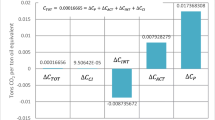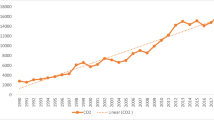Abstract
CO2 contributes a lot to the greenhouse effect. The total CO2 emissions of the two countries, China and the USA, as the world’s top two economies, have exceeded 40% of the total global carbon emissions. In this context, the exploration of the evolution of carbon emissions from energy consumption in China and the USA and the comparison of the characteristics of carbon emission drivers in different periods play a significant role in the policy formulation and climate change cooperation between China and the USA. In this study, the BP structural breakpoint test was used to divide the carbon emission stages of China and the USA from 1970 to 2019. The generalized Divisia index model (GDIM) was developed to decompose the growth of carbon emissions in China and the USA into eight items, GDP, carbon intensity of GDP, energy use, carbon intensity of energy, population, carbon emissions per capita, GDP per capita, and energy intensity, and to analyze the characteristics and cumulative contribution of carbon emission drivers at each stage. Based on the stage and cumulative characteristics of carbon emissions between China and the USA, the USA should take the initiative to assume the legal responsibility of carbon emissions and further deepen the cooperation with other countries in the field of climate change. China should transform the economic growth mode, optimize the energy structure, and improve the efficiency of resource utilization to help achieve the peaking carbon emissions and the carbon neutrality smoothly.








Similar content being viewed by others
Data availability
References
Anonymous (2008) Complinet; Wall Street and politics: new survey from complinet finds McCain would provide the most reassurance to Wall Street; Reagan is president that did most for U.S. economy, regulations ‘hinder’ more than help. Politics & Government Business. Available online: https://schlr.cnki.net/zn/Detail/index/GARJ0010_4/SPQD00001457841. Accessed 24 Sep 2021
SalhaOusama Ben Salha, Besma Hkiri, Chaker Aloui (2016) Sectoral energy consumption by source and output in the U.S.: new evidence from wavelet-based approach. Energy Econ 72:75–96. https://doi.org/10.1016/j.eneco.2018.03.029
Li Bo et al (2020) Feasibility assessment of the carbon emissions peak in China’s construction industry: factor decomposition and peak forecast. Sci Total Environ 706:135716. https://doi.org/10.1016/j.scitotenv.2019.135716
Brown RL, Durbin J, Evans JM (1975) Techniques for testing the constancy of regression relationships over time. J R Stat Soc Ser B Methodol 37(2):149–192 https://doi.org/10.1111/j.2517-6161.1975.tb01532.x
Den Ji-xiang, Liu Xiao, Wang Zheng, (2014) Characteristics analysis and factor decomposition based on the regional difference changes in China’s CO2 emission. J Nat Resour 29(02):189–200 https://doi.org/10.11849/zrzyxb.2014.02.001
Dong Feng, Yang Qing-liang, Long Ru-yin, Cheng Shuo-bo (2015). Factor decomposition and dynamic simulation of China’s carbon emissions. Chin J Popul Resour Environ 25(04):1–8 https://doi.org/10.3969/j.issn.1002-2104.2015.04.001
1998.Estimating and testing linear models with multiple structural changes. Econometrica 66(1):47–78
Dan Fan (2013) Driving factors of carbon emissions from energy consumption in China-based on LMDI-PDA method. China Environ Sci 33(09):1705–1713
Gay Charles F, Moon Susan, Howard (1998). Momentum at last: perspectives on the U.S. renewable energy industry. Energy Sources 20(2):97–102 https://doi.org/10.1080/00908319808970048.
Giray Gozgor, et al. (2019) Dependence structure between business cycles and CO 2 emissions in the U.S.: evidence from the time-varying Markov-switching copula models[J]. Energy 188(C):115995–115995 https://doi.org/10.1016/j.energy.2019.115995
Hong Huo, et al. (2015) Life-cycle assessment of greenhouse gas and air emissions of electric vehicles: a comparison between China and the U.S. Atmos Environ 108:107–116 https://doi.org/10.1016/j.atmosenv.2015.02.073
Huanan Li, et al. (2011) Analysis on influence factors of China’s CO2 emissions based on Path–STIRPAT model. Energy Policy 39(11):6906–6911 /https://doi.org/10.1016/j.enpol.2011.08.056
Irene Teshamulwa Okioga, et al. (2018) Renewable energy policy formulation for electricity generation in the United States. Energy Strategy Reviews 22:365–384 https://doi.org/10.1016/j.esr.2018.08.008
Jacoby Sergey Paltsev (2013) Nuclear exit, the U.S. energy mix, and carbon dioxide emissions. Bull Atom Sci 69(2):34–43 https://doi.org/10.1177/0096340213478553
Bai Jushan, Pierre Perron (2003). Computation and analysis of multiple structural change models. Journal of Applied Econometrics, 18(1): 1-22https://doi.org/10.1002/jae.659
Bo-qiang Lin, Dong-xin Mao (2014) Characteristics of China’s carbon emission intensity in different development stages. J Financ Res 08:101–117
Lu Wanbo, Qiu Tingting, Du Lei (2013) A study on influence factors of carbon emissions under different economic growth stages in China. Eco Res J 48(545(04)):106–118
Singh Mahendra Kumar, Mukherjee Deep (2019) Drivers of greenhouse gas emissions in the United States: revisiting STIRPAT model. Environ Dev Sustain 21(6):3015–3031 https://doi.org/10.1007/s10668-018-0178-z
Ma Xiaowei, Du Jia, Ye Yi, et al. (2015) A study of comparison of carbon emissions accounting from household energy consumption between China and United States of American. J Beijing Inst Technol (Social Sciences Edition) 17(04):34–40 https://doi.org/10.15918/j.jbitss1009-3370.2015.0405
Olivier JGJ, Peters JW (2020) Trends in global CO2 and total greenhouse gas emissions: 2020 report. PBL Netherlands Environmental Assessment Agency. Available online: http://www.indiaenvironmentportal.org.in/files/file/greenhouse%20gas%20emissions%202020%20report.pdf. Accessed 25 Nov 2021
Fernández González P, Landajo M, Presno MJ (2014) Multilevel LMDI decomposition of changes in aggregate energy consumption. A cross country analysis in the EU-27. Energy Policy 68:576–584
PAGE ES (1954) Continuous inspection schemes. Biometrika, 41(1-2):100-115 https://doi.org/10.1093/biomet/41.1-2.100
Ramakrishnan Ramanathan (2004) Evaluating the comparative performance of countries of the Middle East and North Africa: a DEA application. Socio-Econ Plann Sci 40(2):156–167 https://doi.org/10.1016/j.seps.2004.10.002.003
Xiao-song Ren, Tao Zhao (2004) The dynamic causality relationship between CO2 emissions intensity and its influencing factors in China—under the perspective of expandable KAYA equation. J Arid Land Resour Environ 28(03):6–10
Salari Mahmoud, Javid Roxana J, Noghanibehambari Hamid (2021) The nexus between CO2 emissions, energy consumption, and economic growth in the U.S. Econ Anal Policy 69:182–194 https://doi.org/10.1016/J.EAP.2020.12.007
Shuai Shao, Xi Zhang, Xing-rong Zhao (2017) Empirical decomposition and peaking pathway of carbon dioxide emissions of China’s manufacturing sector——generalized Divisia index method and dynamic scenario analysis. China Ind Econ 03:44–63. https://doi.org/10.19581/j.cnki.ciejournal.2017.03.003
Sun Huaping, Chen Lizhen (2014) An empirical study on the impact of carbon emissions on Sino-US agricultural trade. Macroeconomics 2014(02):137–143 https://doi.org/10.16304/j.cnki.11-3952/f.2014.02.011
Tong Xinhua, Zhou Hongyan, et al. (2020) Study on the measurement of carbon-driven effects from different development stages of industrialization. China Popul Resour Environ 30(5):26–35
Vaninsky Alexander (2014) Factorial decomposition of CO2 emissions: a generalized Divisia index approach. Energy Econ 45:389–400 https://doi.org/10.1016/j.eneco.2014.07.008
Victor Moutinho, et al. (2018) Factors affecting CO 2 emissions in top countries on renewable energies: a LMDI decomposition application. Renew Sustain Energy Rev 90:605–622 https://doi.org/10.1016/j.rser.2018.02.009
Wang Feng, Wu Li-hua, Yang Chao (2010) Driving factors for growth of carbon dioxide emissions during economic development in China. Econ Res J 45(02):123–136
Wang Haili, He Xiaoyi, Zhang Xiliang (2015) A comparative analysis of the post-2020 CO2 emission reduction target set by China and the United States. China Popul Resour Environ 25(06):23–29
Wang Yong, et al. (2018) Influencing factors and decoupling elasticity of China’s transportation carbon emissions. Energies 11(5):1614—7499 https://doi.org/10.1007/s11356-021-15548-0
Wilbur Zelinsky (2016) The industrial structure of American cities: a geographic study of urban economy in the United States. Econ Geogr 33(3):275–276 https://doi.org/10.2307/142314
Xiang Liu, Jia Liu (2016) Measurement of low carbon economy efficiency with a three-stage data envelopment analysis: a comparison of the largest twenty CO2 emitting countries. Int J Environ Res Public Health 13(11):1660–4601 https:// doi.org/1660-4601/13/11/1116
Xu Shi-Chun, et al. (2016) Factors that influence carbon emissions due to energy consumption based on different stages and sectors in China. J Clean Prod 115:139–148 https://doi.org/10.1016/j.jclepro.2015.11.050
Yan Qing-you, Jiao Yan-hua (2018) Optimal environment-friendly economic restructuring of Beijing. Int J Educ Econ 1(1)19, 232:1402–1417
Yan Qing-you, et al. (2019) Analysis of China’s regional thermal electricity generation and CO 2 emissions: decomposition based on the generalized Divisia index. Sci Total Environ 682:737–755 https://doi.org/10.1016/j.enpol.2011.08.056
Yan Qing-you, et al. (2019) Coordinated development of thermal power generation in Beijing-Tianjin-Hebei region: evidence from decomposition and scenario analysis for carbon dioxide emission. J Clean Prod 232:1402–1417 https://doi.org/10.1016/j.jclepro.2019.05.256
Qing-you Yan, Jie-ting Yin (2017) Factor decomposition of carbon emissions in Beijing, Tianjin, Hebei: a study based on generalized Divisia index method. Sci Technol Manag Res 37(19):239–245
Weihua Yin (2019) Changes and driving factors of embodied carbon emissions intensity in China’s export trade —based on CM RIO and SDA model. Inq Econ Issues 12:123–134
Dong-hua Yu (2019) New trend of global manufacturing industry development and its impact on China in the New Industrial Revolution era. Tianjin Soc Sci 02:88–100
Yuan Peng, Cheng Shi, Liu Hai-yang (2012) The effect of international trade on CO2 emissions growth in China: based on a method combined SDA with LMDI. Econ Rev (01):122–132 https://doi.org/10.19361/j.er.2012.01.014
Zhang Yu-Ming, Hu Chun-Sheng, et al (2011) Research advances on source/sink intensities and greenhouse effects of CO2, CH4 and N2O in agricultural soils. Chinese J Eco-Agricul 19(4):966−975. http://www.ecoagri.ac.cn/cn/article/doi/https://doi.org/10.3724/SP.J.1011.2011.00966. Accessed 25 Sep 2021
Zhu Bangzhu, Wang Kefan, et al. (2015) A study of the phased drivers of carbon emissions growth in China. Econ Perspect 657(11):79–89
Zhou Yan-nan, Yang Yu, et al (2020) Regional differences in the coupling relationship between Chinese economic growth and carbon emissions based on decoupling index and LMDI. J Univ Chin Acad Sci 37(03):295–307. http://journal.ucas.ac.cn/CN/https://doi.org/10.7523/j.issn.2095-6134.2020.03.002. Accessed 26 Sep 2021
Zhu Qin, Peng Xi-zhe, Lu Zhi-ming, Wu Kai-ya. (2009) Factors decomposition and empirical analysis of variations in energy carbon emission in China. Resour Sci 31(12):2072–2079. http://www.resci.cn/CN/Y2009/V31/I12/2072. Accessed 22 Sep 2021
Acknowledgements
Financial supports from the Basic Scientific Research Operations of the Central-level Public Interest Research Institutes of the Chinese Academy of Environmental Sciences (2021YSKY-07) are gratefully acknowledged.
Funding
Basic Scientific Research Operations of the Central-level Public Interest Research Institutes of the Chinese Academy of Environmental Sciences (2021YSKY-07) and National Social Science Fund of China (21BJY247)
Author information
Authors and Affiliations
Contributions
NZ: methodology, software, validation, writing — original draft, formal analysis. LHL: conceptualization, supervision. MXZ: data collection, writing — review and editing. MYX: writing — review and editing. ZHB: writing — review and editing. HL: project administration
Corresponding author
Ethics declarations
Ethics approval
Not applicable
Consent to participate
Not applicable
Consent for publication
Not applicable
Conflict of interest
The authors declare no competing interests.
Additional information
Responsible Editor: Marcus Schulz
Publisher's note
Springer Nature remains neutral with regard to jurisdictional claims in published maps and institutional affiliations.
Rights and permissions
About this article
Cite this article
Zhang, N., Lv, L., Zhao, M. et al. A comparative study of stage characteristics and factorial decomposition of CO2 emissions between China and the USA. Environ Sci Pollut Res 29, 48769–48783 (2022). https://doi.org/10.1007/s11356-022-18811-0
Received:
Accepted:
Published:
Issue Date:
DOI: https://doi.org/10.1007/s11356-022-18811-0




